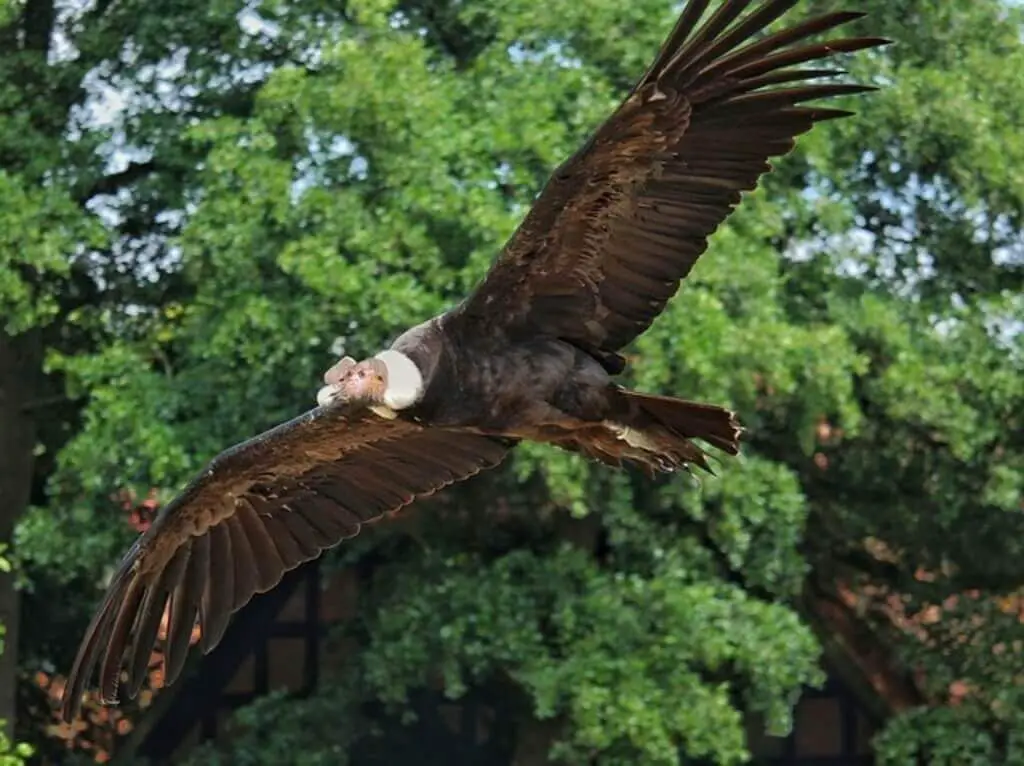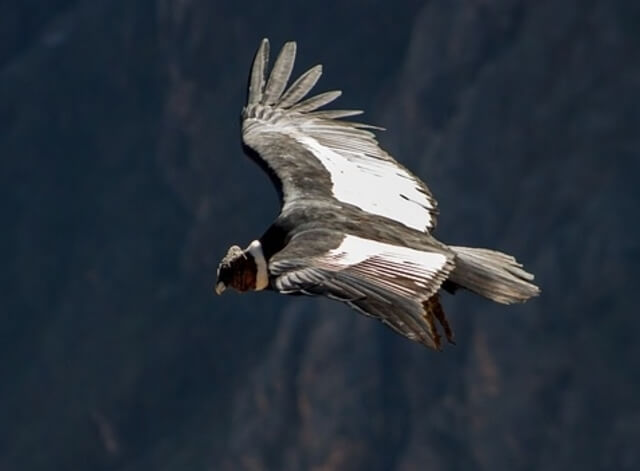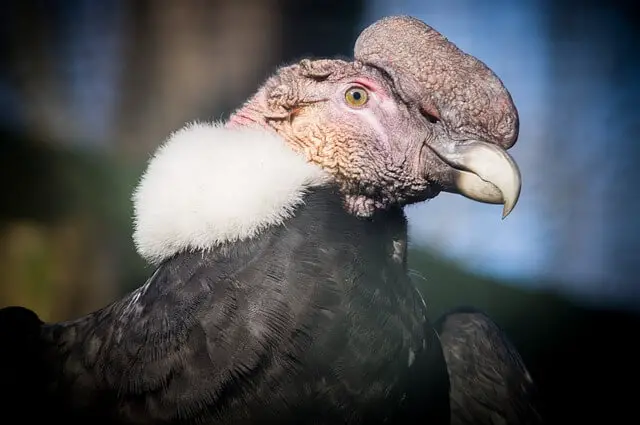The Andean Condor, with its impressive wingspan and regal presence, is one of the most iconic birds in the world. Soaring high above the Andes Mountains, this majestic bird holds a significant place in South American culture and ecosystems.
Dive into these 43 fascinating facts to uncover the secrets and wonders of the Andean Condor, from its unique behaviors to its vital role in nature. Whether you’re a bird enthusiast or simply curious about wildlife, these insights will give you a deeper appreciation for this magnificent species.
Table of Contents
- 1 Andean Condor (Overview)
- 2 Facts About The Andean Condor
- 2.1 Impressive Wingspan
- 2.2 High-Altitude Soarers
- 2.3 Vultures or Not?
- 2.4 Slow Reproduction
- 2.5 Long-Lived
- 2.6 Distinctive Plumage
- 2.7 Efficient Scavengers
- 2.8 Intimidating Presence
- 2.9 Cultural Significance
- 2.10 Slow Takeoff
- 2.11 Social Creatures
- 2.12 Conservation Concerns
- 2.13 Ecosystem Engineers
- 2.14 Unique Courtship Rituals
- 2.15 Incredibly Heavy
- 2.16 Conservation Success
- 2.17 Symbol of Endurance
- 2.18 Scientific Study
- 2.19 Protected Status
- 2.20 Awe-Inspiring Sight
- 2.21 Thermal Riding Experts
- 2.22 Low Metabolic Rate
- 2.23 Apex Scavengers
- 2.24 Large Roosting Communities
- 2.25 Mysterious Migration
- 2.26 Extraordinary Senses
- 2.27 Ancient Avian Lineage
- 2.28 High-Altitude Nests
- 2.29 Limited Vocalizations
- 2.30 Endangered Status
- 2.31 Broad Geographic Range
- 2.32 Natural Pest Controllers
- 2.33 Incubation and Parenting
- 2.34 Feeding Habits
- 2.35 Mate for Life
- 2.36 Revered in Folklore
- 2.37 Challenging Predators
- 2.38 Distinctive Finger Structure
- 2.39 Roosting in Caves
- 2.40 Nomadic Behavior
- 2.41 Vulnerable Juvenile Stage
- 2.42 Adapted for High Altitudes
- 2.43 Territorial Creatures
- 3 Conclusion
- 4 Author
Andean Condor (Overview)
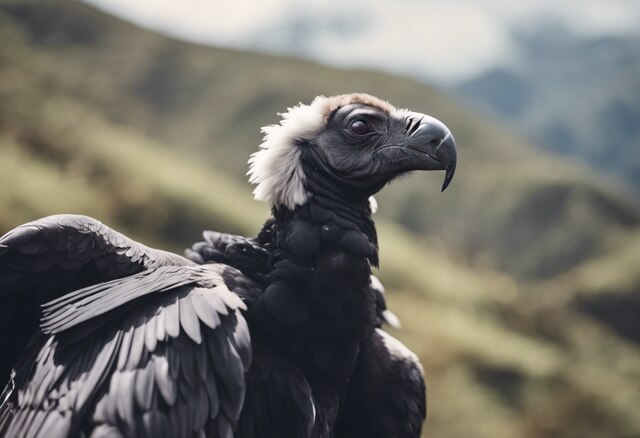
| Andean Condor Facts | |
|---|---|
| Coloration | Black and white plumage with a white collar around the neck |
| Size | Large to very large, with an average length of about 45 inches (115 cm) |
| Weight | Adult Andean Condors can weigh up to 33 pounds (15 kilograms) |
| Wingspan | Impressive wingspan of up to 11 feet (3.3 meters) |
| Range | Andean Condors are primarily found in the Andes Mountains of South America |
| Habitat | High-altitude regions, including mountains, cliffs, and open skies |
| Location | Predominantly in countries such as Peru, Chile, Ecuador, Bolivia, and Argentina |
| Diet | Carrion (the flesh of dead animals) makes up their primary diet |
| Lifespan | Some individuals can live over 70 years in captivity |
| Predators | Adult Andean Condors have few natural predators due to their size and strength |
| Top Speed | They can reach speeds of up to 50 miles per hour (80 kilometers per hour) |
| Conservation Status | Considered near-threatened, with efforts to protect and conserve their populations |
Facts About The Andean Condor
Impressive Wingspan
Andean Condors are renowned for their remarkable wingspan, which can reach up to an astonishing 11 feet (3.3 meters). This enormous wingspan enables them to glide effortlessly over the Andes Mountains, where they are commonly found.
High-Altitude Soarers
Thriving in some of the world’s highest-altitude environments, Andean Condors are often spotted at elevations exceeding 16,000 feet (4,800 meters). They are masters of using thermal air currents to gain altitude and cover vast distances in their mountainous habitats.
Vultures or Not?
Despite their appearance and scavenging habits, Andean Condors are not classified as true vultures. Instead, they belong to the group of New World vultures, which includes condors and other carrion-eating birds found in the Americas.
Slow Reproduction
Andean Condors exhibit a notably low reproductive rate. Female condors lay eggs only once every two years on average. Once hatched, their chicks require an extended period of dependency and care before becoming self-sufficient.
Long-Lived
These remarkable birds are among the longest-lived avian species, with some individuals living for over 70 years in captivity. Their impressive longevity adds to their mystique and significance.
Distinctive Plumage
Andean Condors are easily recognized by their striking black plumage, complemented by a conspicuous white collar of feathers encircling their necks. Juvenile condors, however, have mottled brownish plumage, which gradually transitions to the adult black and white pattern.
Efficient Scavengers
These avian giants primarily subsist on a diet of carrion. Their keen eyesight allows them to spot carcasses from remarkable heights, making them efficient scavengers and critical members of their ecosystems.
Intimidating Presence
Due to their imposing size, majestic flight patterns, and prevalence in the Andes, Andean Condors have historically been considered symbols of power and strength in various Andean cultures. They are often associated with reverence and respect.
Cultural Significance
Beyond their symbolic importance, Andean Condors hold cultural significance in many indigenous communities across the Andes. They are sometimes featured in myths and legends, representing freedom and the spiritual connection between humans and nature.
Slow Takeoff
Despite their exceptional gliding abilities, Andean Condors face a unique challenge during takeoff. Their massive size requires them to run and leap off cliffs to gain enough initial lift for flight, a mesmerizing sight for observers.
Social Creatures
Unlike many solitary bird species, Andean Condors are known to be social birds, often gathering in groups at communal roosting sites. These gatherings provide opportunities for social interactions, mutual preening, and information exchange about food sources.
Conservation Concerns
Andean Condors face significant conservation challenges due to habitat loss, poisoning from ingesting lead ammunition in carrion, and unintentional trapping. Conservation efforts are underway to protect these iconic birds and their habitats.
Ecosystem Engineers
These birds play a crucial role in their ecosystems by scavenging carrion. In doing so, they help prevent the spread of diseases and maintain the ecological balance in their habitats.
Unique Courtship Rituals
Andean Condors engage in elaborate courtship displays to attract mates. These displays involve intricate dances, vocalizations, and impressive aerial acrobatics that can be seen as expressions of their strength and vitality.
Incredibly Heavy
Despite their soaring abilities, Andean Condors are heavy birds, with some individuals weighing up to 33 pounds (15 kilograms). Their powerful wings are well-suited to carrying their substantial weight during flight.
Conservation Success
In some areas, conservation efforts have led to population recoveries, showcasing the positive impact of dedicated conservation initiatives and public awareness on protecting these magnificent birds.
Symbol of Endurance
Andean Condors are a symbol of endurance and resilience. They have adapted to thrive in some of the harshest mountain environments on Earth, facing extreme temperature fluctuations and thin oxygen levels.
Scientific Study
Scientists and researchers study Andean Condors to better understand their behavior, ecology, and role in their ecosystems. Tracking devices and tagging programs have provided valuable insights into their movements and habitat preferences.
Protected Status
Due to their vulnerable status in the wild, Andean Condors are legally protected in many countries, making it illegal to harm or capture them. These legal protections are crucial for their survival.
Awe-Inspiring Sight
Witnessing the graceful flight and majestic presence of an Andean Condor soaring above the rugged Andes Mountains is a truly awe-inspiring experience, leaving a lasting impression on those fortunate enough to encounter them in the wild.
Thermal Riding Experts
Andean Condors demonstrate exceptional mastery of thermal air currents. They gracefully ascend to great heights without the need for frequent wing flapping, conserving energy for their extensive flights over the Andes’ challenging terrains.
Low Metabolic Rate
These majestic birds possess a notably slow metabolic rate, which is an invaluable adaptation in their high-altitude habitats. Their ability to endure extended periods without sustenance helps them survive in the rugged Andes Mountains.
Apex Scavengers
As apex scavengers, Andean Condors occupy the highest tier in the scavenging hierarchy. Their dominance is essential for ecosystem health, as they efficiently remove carrion, reducing the risk of disease transmission.
Large Roosting Communities
Andean Condors are known for congregating in large roosting communities. These gatherings often comprise hundreds of birds, providing safety through numbers and fostering social interactions.
Mysterious Migration
Intriguingly, some Andean Condors engage in seasonal migrations. During harsh Andean winters, they venture to lower elevations in search of food, unveiling an aspect of their adaptability and behavior.
Extraordinary Senses
Their exceptional sense of smell allows Andean Condors to detect the scent of carrion from remarkable distances. This acute olfactory ability enables them to efficiently pinpoint food sources, contributing to their survival.
Ancient Avian Lineage
Andean Condors represent an ancient avian lineage with a history dating back millions of years. Their evolutionary heritage provides valuable insights into the dynamics of Earth’s ecosystems.
High-Altitude Nests
Nesting at astonishing elevations of up to 16,000 feet (4,800 meters) on sheer cliff faces, Andean Condors showcase their remarkable adaptability to extreme environments.
Limited Vocalizations
These majestic birds are relatively silent, primarily communicating through hisses and grunts. Their vocal restraint contrasts with their impressive visual displays during courtship rituals.
Endangered Status
Sadly, Andean Condors are considered near-threatened due to habitat loss and poisoning from ingesting lead ammunition in carrion. Conservation efforts are essential to safeguard these iconic birds.
Broad Geographic Range
Andean Condors have a broad geographic distribution, spanning the Andes Mountains from Venezuela to Patagonia, showcasing their adaptability to diverse ecosystems.
Natural Pest Controllers
Their role as scavengers extends to carrion removal, which helps control populations of disease-carrying pests and keeps ecosystems in balance.
Incubation and Parenting
Andean Condor parents take turns incubating their single egg and caring for the chick. The chick has a long developmental period, requiring parental care for an extended duration.
Feeding Habits
While primarily carrion eaters, they may also feed on live prey if the opportunity arises, showcasing their versatility as opportunistic hunters.
Mate for Life
Andean Condors are known to form long-term monogamous bonds, with pairs often staying together for many years or even life.
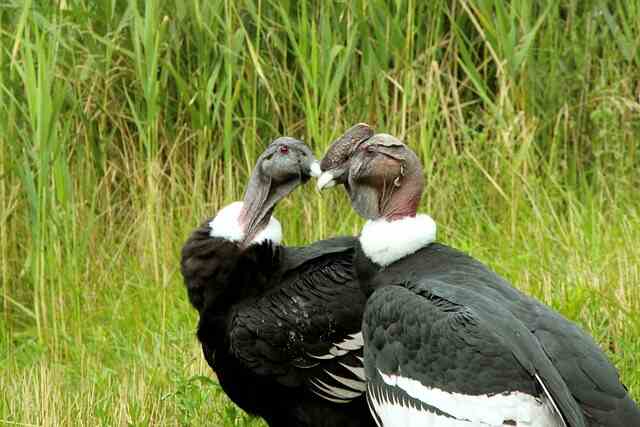
Revered in Folklore
These magnificent birds hold a significant place in Andean folklore and indigenous cultures, where they are often revered as symbols of power, spirituality, and the connection between humans and nature.
Challenging Predators
While Andean Condors are formidable and agile in the air, they still face threats from larger predators like pumas and foxes when grounded.
Distinctive Finger Structure
These birds have a unique finger structure, where one finger is longer than the others, helping them maintain wing stability during flight.
Roosting in Caves
They often roost in caves, cliffs, or other rocky shelters, providing protection from the elements and potential predators.
Nomadic Behavior
Some Andean Condors exhibit nomadic tendencies, traveling over large distances in search of food, which can lead to widely varying flight patterns.
Vulnerable Juvenile Stage
Young condors face significant mortality rates during their first few years, making it a challenging stage of their lives.
Adapted for High Altitudes
Andean Condors have specialized hemoglobin that allows them to efficiently extract oxygen from the thin air at high altitudes, aiding their soaring flights.
Territorial Creatures
They are highly territorial birds, with individuals and pairs defending vast home ranges to secure access to food resources.
Conclusion
In conclusion, the Andean Condor is a testament to nature’s extraordinary creations. With its colossal wingspan, adaptability to high altitudes, and vital role as an apex scavenger, it stands as a symbol of strength and resilience in the Andes Mountains.
These incredible birds, with their striking plumage and impressive longevity, are not only remarkable in their own right but also hold deep cultural significance in the regions they call home.
As we marvel at their ability to soar over rugged landscapes and navigate the thin mountain air, let us also recognize the importance of conservation efforts aimed at safeguarding these magnificent creatures for generations to come.
Exploring the world of the Andean Condor leaves us with a profound appreciation for the wonders of the natural world and the need to protect and preserve its awe-inspiring inhabitants.

